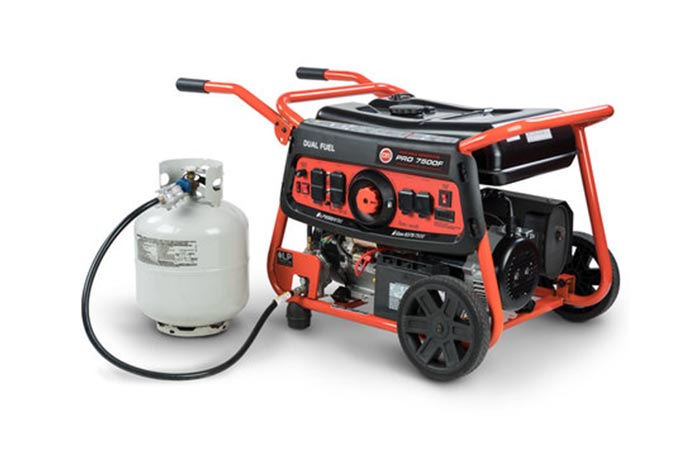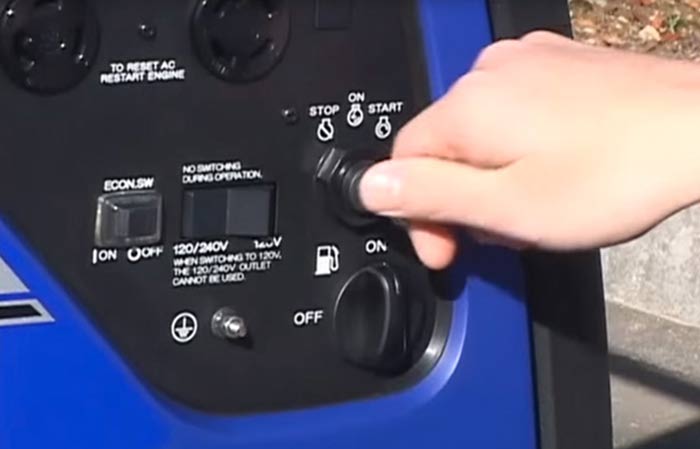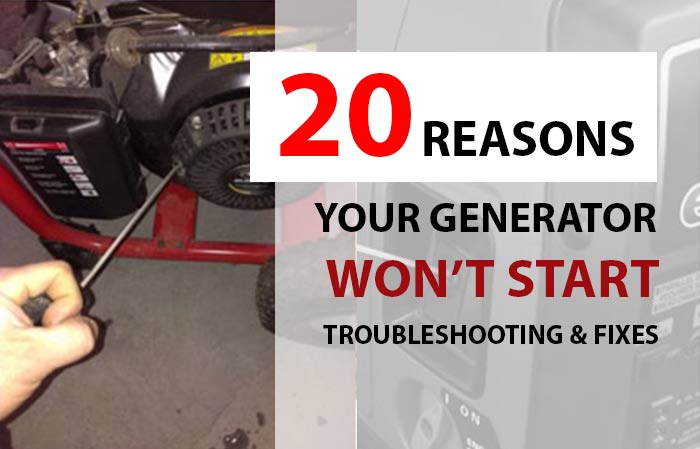Whether your generator is a new or used one, it may fail to start. The causes of such an issue range from simple ones such as low oil or fuel, wrongly positioned levers to complex ones such as worn out parts that need replacing.
For each of these causes, there are solutions you can carry out on your own or enlist the services of an expert. The good news is that generators are small engines which have fewer parts compared to a vehicle for example. As such, finding and fixing the issue doesn’t take as much time and skill as for the case of larger engines.
In this guide, we look at the issues that may affect both new and used generators and prevent them from starting. While you can fix most of them, leave the complex ones to an expert either from the manufacturer or from the local generator repair garage.
Generator Won’t Start: Causes and Solutions
The causes and solutions are as follows:
It’s out of gas
The most obvious reason is that the generator has no gasoline to run on. This is an issue affecting both new and old generators. For a new one, it’ll be that it doesn’t have the gas at all as they don’t come with gas in them. For a used one, it could have run out of gas or the gas could be stale. With ethanol a component of the gas, it absorbs water reducing its efficiency as a fuel.
Solution
The solution to the lack of gas is simply adding gasoline to the fuel tank to the recommended level. Practice caution when doing so as gasoline is highly flammable. As such, don’t add the fuel when the generator is running or still hot from running. Besides that, don’t use gasoline that hasn’t been used for 2 months since it’ll likely be stale.

Clogged or closed fuel valve
Another problem affecting both new and used generators and that may prevent their starting is a clogged or closed fuel valve. A clogged fuel valve is likely to affect a used generator than a new one. Either issue will not allow fuel to get to the carburetor.
The fuel valve is the part controlling the flow of fuel to the rest of the generator and it has a lever to either open or close it. Before starting the generator, you have to open it then close it when the generator is turned off.
Solution
If you’re sure there’s fuel in the tank and the generator won’t start, check whether the fuel valve is turned ON or OPEN for the fuel to flow. If, even after doing this it still won’t start, do one or both of these things:
- Open the vacuum relief valve at the top of the tank to release any air that may have been trapped in the piping system. Air can cause a blockage called an airlock which will prevent the free flow of fuel to the carburetor.
- Unplug the outlet hose on the side of the intake of the fuel valve to check whether fuel is flowing or not. This may spill some of the fuel and you’ll thus need a clean and dry container to empty the fuel in. If the fuel is flowing, return the pipe to the intake and try starting the generator again. If not, close the fuel valve then clean it before trying again.
These methods will open the fuel valve, allow the flow of fuel to the carburetor and the starting of the generator.
Malfunctioning spark plug
The spark plug has the role of igniting the mixture of air and fuel in the piston chamber resulting into small explosions which turn the engine piston and give the engine power. A generator will usually only have one spark plug given its diminutive size compared to that of a car.
If the generator is a new one and it’s a spark plug issue, it’ll simply be a connection issue and refitting it will do the trick. For a previously used generator, it could either be a connection issue, a dirty plug or a failing one. One or a combination of these issues will prevent the generator from starting.
Solution
For a poorly fitted spark plug, unscrewing it then screwing it back can do the trick. You should also check the generator’s manual for the right gap for your electrode. If all the specifications are right, refit it back then try starting the generator again.
To find out if the spark plug is dirty, you’ll have to remove it from the generator then check the lower part. If dirty, clean it with a small knife or other blade. Be careful not to damage it (although they’re quite tough). Avoid cleaning it with water and instead use some petrol to clean the debris off it.
To check whether the plug is malfunctioning, pull the recoil starter as you hold the spark plug’s body onto the crankcase of the engine. If you see bright blue sparks, the plug is in good condition. if the sparks are weak or aren’t just there, the plug could be faulty.
Before heading out to buy a new one, put the plug’s wire on the body of the engine as you pull the recoil starter. If you see sparks, it means the plug is faulty and needs to be replaced. If not, the ignition coil would be the faulty part.
A dead battery
A dead battery is usually the issue for electric start generators. This won’t be a concern for a new generator but for a used one due to use and disuse of the battery. Often, the battery will die off if the generator has been off for a considerable period of time. If the generator starts with the pull coil but not the electric start, it’s definitely an issue with the battery.
Solution
If the generator has a starter coil, use that to start it in the meantime. This will charge the battery back to its usual level and it will work after running the generator for a while. If this doesn’t work, the battery could be dead in that it can’t take any more charging. For such a case, buying a new battery is the only solution.
If, however, your generator has no recoil starter and the battery won’t work to start it, use a 3rd party battery charger or use another battery to start it then let it charge its own battery.

Clogged air filter
The air filter has the task of filtering air then letting it into the carburetor where it mixes with fuel for ignition by the spark plug. If it’s clogged or not in working condition, air will not flow to the carburetor and the generator won’t start. Keep in mind that, even if fuel flows to the carburetor, it can’t be ignited without the supply of air (oxygen) to enable sparking.
Solution
To check the air filter, you’ll need to open the air filter housing which is located on the side of the generator. If you can’t see it right away, consult your generator’s manual. Check the spongy air filter element for debris that may be keeping the air from reaching the carburetor. Clean it if needed.
There’s too little oil
Engine oil is important in lubricating the running the generator and the low-oil sensor will not allow the generator to start even if everything else is in the proper condition but the oil is low. This can occur when the generator is also on uneven ground as it may tilt away from the sensor thus giving the impression that there’s too little oil.
Solution
Before trying to run the engine, check the engine oil since running it may change the oil level. If you already tried to start it and it failed, wait until the oil level settles then check it again. Make sure the generator is on level ground as you check. If it’s low, add the recommended oil for your generator brand.
Choke lever in the wrong position
Before starting the generator, the choke should lever should be on the CLOSED position. You then have to move it to the OPEN section as the engine starts running. This usually confuses a lot of people since OPEN sounds much easier for when you’re starting the generator and CLOSE for when you’re shutting it down. However, you have to master that at all times.
The choke can be located in various sections of the generator although most generators have it right above the air filter. In some models such as WEN, the choke is built into the power control knob.
Solution
If you’re starting the generator for the first time, make sure the choke lever is on the CLOSED/OFF position before starting it. Once it starts, turn it to the OPEN/ON/RUN position. If the engine is still warm after running for a while, the choke lever can still be in the RUN position and it should work fine.
Air locked or clogged carburetor
Old and stale gasoline can easily clog up your carburetor making it impossible for the generator to start. This usually occurs if the generator hasn’t been started for over a month.
Solution
The solution to this issue is draining and/or cleaning the carburetor. Start by shutting off the fuel valve then opening the carburetor drain located at the bottom of the carburetor’s bowl. If after this the generator doesn’t start still, remove the whole bowl then clean it out before drying it. You then clean the main jet which is the nozzle in the central stem made of brass. The nozzle should be cleaned with a pin or needle. Refit the bowl to its position then try starting the generator again.
To prevent a repetition of this issue, always run your generator at least once a month. If you store it for long, always replace the stale gasoline with fresh fuel.
Malfunctioning low-oil sensor
The oil sensor is meant to ensure the generator doesn’t ever run without the right amount of oil since the damage to the engine would be irreparable. As such, if it malfunctions at any time, the generator will not work to prevent damage.
Solution
You will have to check for the integrity of the low-oil sensor by disconnecting the wire coming out from the side of the crank case. This wire connects the engine to the low-oil sensor and may be located in different places depending on the brand of the generator. If you remove this wire and the generator still starts, it’s a sign that the low-oil sensor isn’t working.
This can be solved by disconnecting the wire described above, running the engine for a few minutes then reconnecting it will usually solve the issue. Only try this if the generator has enough oil in it. If this doesn’t work, you’ll need the input of an expert to locate and fix the low-oil sensor as it’s usually buried deep into the engine.
The generator is plugged into the power output
Trying to start the generator with the power output cord plugged in will only make it hard for the generator to start. Generator engines aren’t usually powerful enough to start and immediately supply power to the outlet. Besides that, you run the risk of causing a power surge that may fry your electronics.
Solution
Always unplug any cords and plugs from the generator before starting the engine. After starting the engine, wait for it to stabilize its roar before connecting the power output to your house.
Faulty recoil starter
The role of the recoil starter is to engage the crankshaft which in turn runs the engine at the start. It may not be properly fitted such that it doesn’t engage the crankshaft correctly. In some cases, it’ll be simply disconnected from the crankshaft. Other times it may be broken inside. The rope for the recoil starter can also be cut or tangled.
Solution
Remove the cover to the recoil starter and check for any broken parts inside. Check for the connection between the starter and the crankshaft. Also, check that the rope connecting to the recoil starter isn’t broken or tangled. If any part is damaged, a replacement should be sought before restarting the generator. If it already has an electric start switch, use that in the meantime.
Faulty start switch
A faulty start switch will also prevent the generator from starting. You can test its effectiveness by the use of a multimeter.
Solution
If all the connections to the start switch are in good condition yet it doesn’t work, it could have a problem. If you can’t access a multimeter, try starting the generator with a recoil starter. If this one works, it means the switch is faulty.
Malfunctioning ignition coil
The ignition coil supplies power to the spark plugs which in turn ignites the fuel causing a chain reaction that provides power to the engine. If it doesn’t work properly, the generator will not even start.
Solution
Ignition coils don’t easily get damaged but if they do, you’ll just need to replace it with another one. However, before buying a new one, check the wires connecting the coil to the rest of generator and make sure they’re in the proper working condition.
Safety switch
If the safety switch to your generator isn’t working, it may not start. This is also advantageous in that it’ll protect your generator in the case of electric shock or other issues.
Solution
Test the safety switch using a multimeter to determine if it’s effective or not. If it is, simply buy another one then fix it before trying to start the generator again.
Broken flywheel key
The flywheel key is a small piece of metal that fits into the crankshaft. It engages the flywheel when the generator is on. Often, it can break if the generator suddenly stops. If this occurs, it could be sheared in half. The next time you try turning the generator on, it’ll not work without this piece.
Solution
Inspect this issue by removing the flywheel from the engine (under the crankshaft from the side of the recoil starter). If the flywheel key is broken, simply buy another one as a replacement.
Faulty ON/OFF switch
Like the other switches, when the ON/OFF switch isn’t working, the generator will not start no matter how many times you try it.
Solution
Check that the electric circuit connecting this switch to the rest of the generator is working properly. If it is and the switch still doesn’t work, the switch would be faulty. If you have a multimeter on hand, you can use it to test the switch as well. If it’s a faulty one, buying a replacement is the solution.
Low temperatures
In cold temperatures such as during the winter, it’s tough running electronics as they easily freeze up and become dysfunctional. Generators are vulnerable to this as they’re mostly outdoors in the cold.
Solution
The solution to this is proper insulation and preheating the generator before starting it. You do this by turning the ignition key to the preheat setting then wait until the temperature signal turns to green from orange. That is when you can start the generator.
The other option is providing the right insulation. This means you need to provide insulation from the cold outside but still provide enough aeration to prevent the buildup of carbon monoxide. You can even leave the heater running but at a low temperature to prevent the freezing of the parts.
Malfunctioning fuel filter
The fuel filter prevents any dirt and debris in the fuel from getting to the carburetor and clogging it up or even damaging it. When it’s not in good working condition due to being clogged with dirt, the carburetor will not be getting enough fuel to start or even run the generator. You may also notice that the generator starts but stutters rather than running smoothly.
Solution
Open the fuel filter then check for debris. If you see it clogged up, clean it, dry it then refit it before trying to start the generator again.
Water in the fuel
Diesel generators have a water separator that’s visible on the side as a piece of glass. Since water can’t mix with fuel, you’re able to see whether the fuel is pure or mixed with water.
Solution
If you see water or any other funny colors in the water/fuel separator, you can solve this by draining the fuel and water mixture then replacing it with good fuel. The good thing is that the water/fuel separator is also a release valve where you can drain out the bad fuel.
These issues and their respective solutions require you to have good knowledge on what the parts of the generator are and what they do. With a guide like this one, combined with your manual, you’re in a good position to solve the issues involved.
Besides these pointers, it’s always wise to take good care of your generator at all times. Routine maintenance, proper cleaning and keeping it dry help prevent a lot of the issues identified above.
More Generator How-tos & Hacks
- Generator Pull Cord Won’t Retract: Causes & Fixes
- How to Start a Generator: New, Used, With/Out Pull Cord
- Generator Won’t Stay Running: Causes & Fixes
- Generator Running Rough & Not Smoothly-Causes + Fixes
- How to Connect /Hook Generator to House without Transfer Switch
- How to Change Oil in Generator-Step by Step
- How to Clean Generator Air Filter & Housing
- How to Fix an Overloaded Generator
- How to make a Generator Quiet as a Cricket for Camping
- 15+ ways to Secure Portable Generators from Theft & Damage
- Portable Generators Safety Tips Checklist
- How to Make Generator Safe for Your Electronics
